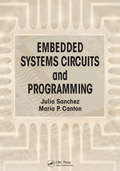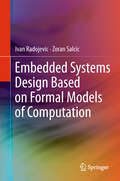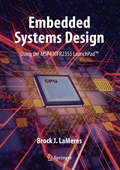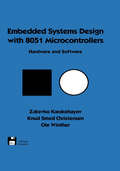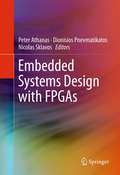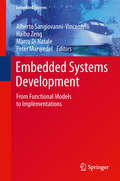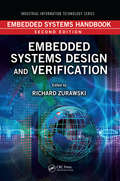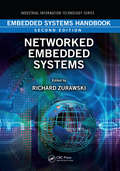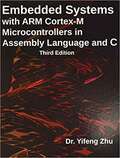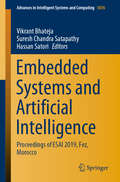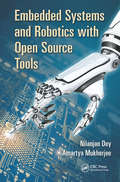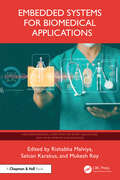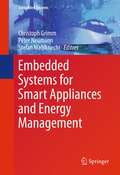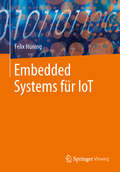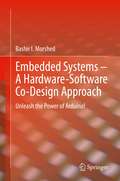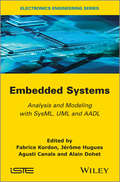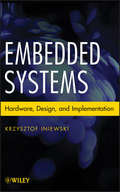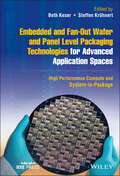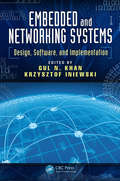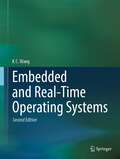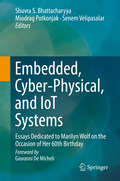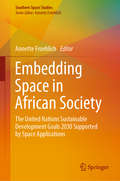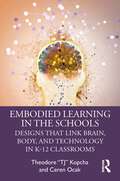- Table View
- List View
Embedded Systems Circuits and Programming
by Julio Sanchez Maria P. CantonDuring the development of an engineered product, developers often need to create an embedded system—a prototype—that demonstrates the operation/function of the device and proves its viability. Offering practical tools for the development and prototyping phases, Embedded Systems Circuits and Programming provides a tutorial on microcontroller programming and the basics of embedded design. The book focuses on several development tools and resources: Standard and off-the-shelf components, such as input/output devices, integrated circuits, motors, and programmable microcontrollers The implementation of circuit prototypes via breadboards, the in-house fabrication of test-time printed circuit boards (PCBs), and the finalization by the manufactured board Electronic design programs and software utilities for creating PCBs Sample circuits that can be used as part of the targeted embedded system The selection and programming of microcontrollers in the circuit For those working in electrical, electronic, computer, and software engineering, this hands-on guide helps you successfully develop systems and boards that contain digital and analog components and controls. The text includes easy-to-follow sample circuits and their corresponding programs, enabling you to use them in your own work. For critical circuits, the authors provide tested PCB files.
Embedded Systems Design Based on Formal Models of Computation
by Zoran Salcic Ivan Radojevic"Models of Computation for Heterogeneous Embedded Systems" presents a model of computation for heterogeneous embedded systems called DFCharts. It targets heterogeneous systems by combining finite state machines (FSM) with synchronous dataflow graphs (SDFG). FSMs are connected in the same way as in Argos (a Statecharts variant with purely synchronous semantics) using three operators: synchronous parallel, refinement and hiding. The fourth operator, called asynchronous parallel, is introduced in DFCharts to connect FSMs with SDFGs. In the formal semantics of DFCharts, the operation of an SDFG is represented as an FSM. Using this representation, SDFGs are merged with FSMs so that the behaviour of a complete DFCharts specification can be expressed as a single, flat FSM. This allows system properties to be verified globally. The practical application of DFCharts has been demonstrated by linking it to widely used system-level languages Java, Esterel and SystemC.
Embedded Systems Design using the MSP430FR2355 LaunchPad™
by Brock J. LaMeresThis textbook for courses in Embedded Systems introduces students to necessary concepts, through a hands-on approach. LEARN BY EXAMPLE – This book is designed to teach the material the way it is learned, through example. Every concept is supported by numerous programming examples that provide the reader with a step-by-step explanation for how and why the computer is doing what it is doing. LEARN BY DOING – This book targets the Texas Instruments MSP430 microcontroller. This platform is a widely popular, low-cost embedded system that is used to illustrate each concept in the book. The book is designed for a reader that is at their computer with an MSP430FR2355 LaunchPadTM Development Kit plugged in so that each example can be coded and run as they learn. LEARN BOTH ASSEMBLY AND C – The book teaches the basic operation of an embedded computer using assembly language so that the computer operation can be explored at a low-level. Once more complicated systems are introduced (i.e., timers, analog-to-digital converters, and serial interfaces), the book moves into the C programming language. Moving to C allows the learner to abstract the operation of the lower-level hardware and focus on understanding how to “make things work”. BASED ON SOUND PEDAGOGY - This book is designed with learning outcomes and assessment at its core. Each section addresses a specific learning outcome that the student should be able to “do” after its completion. The concept checks and exercise problems provide a rich set of assessment tools to measure student performance on each outcome.
Embedded Systems Design with 8051 Microcontrollers: Hardware and Software (Electrical and Computer Engineering #Vol. 108)
by Zdravko Karakehayov Knud Smed Christensen Ole WintherA presentation of developments in microcontroller technology, providing lucid instructions on its many and varied applications. It focuses on the popular eight-bit microcontroller, the 8051, and the 83C552. The text outlines a systematic methodology for small-scale, control-dominated embedded systems, and is accompanied by a disk of all the example problems included in the book.
Embedded Systems Design with FPGAs
by Dionisios Pnevmatikatos Peter Athanas Nicolas SklavosThis book presents the methodologies and for embedded systems design, using field programmable gate array (FPGA) devices, for the most modern applications. Coverage includes state-of-the-art research from academia and industry on a wide range of topics, including applications, advanced electronic design automation (EDA), novel system architectures, embedded processors, arithmetic, and dynamic reconfiguration.
Embedded Systems Development: From Functional Models to Implementations
by Alberto Sangiovanni-Vincentelli Haibo Zeng Marco Di Natale Peter MarwedelThis book offers readers broad coverage of techniques to model, verify and validate the behavior and performance of complex distributed embedded systems. The authors attempt to bridge the gap between the three disciplines of model-based design, real-time analysis and model-driven development, for a better understanding of the ways in which new development flows can be constructed, going from system-level modeling to the correct and predictable generation of a distributed implementation, leveraging current and future research results.
Embedded Systems Handbook: Embedded Systems Design and Verification
by Richard ZurawskiConsidered a standard industry resource, the Embedded Systems Handbook provided researchers and technicians with the authoritative information needed to launch a wealth of diverse applications, including those in automotive electronics, industrial automated systems, and building automation and control. Now a new resource is required to report on current developments and provide a technical reference for those looking to move the field forward yet again. Divided into two volumes to accommodate this growth, the Embedded Systems Handbook, Second Edition presents a comprehensive view on this area of computer engineering with a currently appropriate emphasis on developments in networking and applications. Those experts directly involved in the creation and evolution of the ideas and technologies presented offer tutorials, research surveys, and technology overviews that explore cutting-edge developments and deployments and identify potential trends. This first self-contained volume of the handbook, Embedded Systems Design and Verification, is divided into three sections. It begins with a brief introduction to embedded systems design and verification. It then provides a comprehensive overview of embedded processors and various aspects of system-on-chip and FPGA, as well as solutions to design challenges. The final section explores power-aware embedded computing, design issues specific to secure embedded systems, and web services for embedded devices. Those interested in taking their work with embedded systems to the network level should complete their study with the second volume: Network Embedded Systems.
Embedded Systems Handbook: Networked Embedded Systems
by Richard ZurawskiConsidered a standard industry resource, the Embedded Systems Handbook provided researchers and technicians with the authoritative information needed to launch a wealth of diverse applications, including those in automotive electronics, industrial automated systems, and building automation and control. Now a new resource is required to report on current developments and provide a technical reference for those looking to move the field forward yet again. Divided into two volumes to accommodate this growth, the Embedded Systems Handbook, Second Edition presents a comprehensive view on this area of computer engineering with a currently appropriate emphasis on developments in networking and applications. Those experts directly involved in the creation and evolution of the ideas and technologies presented offer tutorials, research surveys, and technology overviews that explore cutting-edge developments and deployments and identify potential trends. This second self-contained volume of the handbook, Network Embedded Systems, focuses on select application areas. It covers automotive field, industrial automation, building automation, and wireless sensor networks. This volume highlights implementations in fast-evolving areas which have not received proper coverage in other publications. Reflecting the unique functional requirements of different application areas, the contributors discuss inter-node communication aspects in the context of specific applications of networked embedded systems. Those looking for guidance on preliminary design of embedded systems should consult the first volume: Embedded Systems Design and Verification.
Embedded Systems With Arm (register Mark) Cortex-m Microcontrollers In Assembly Language And C
by Yifeng ZhuSignificant changes in the third edition include updated serial communication description (UART, SPI, and I2C), new serial communication examples, incorporation of GNU gcc compiler, low power modes, modification of example programs from STM32L1 (Cortex-M3) to STM32L4 (Cortex-M4). The book introduces basic programming of ARM Cortex-M cores in assembly and C at the register level, and the fundamentals of embedded system design. It presents basic concepts such as data representations (integer, fixed-point, floating-point), assembly instructions, stack, and implementing basic controls and functions of C language at the assembly level. It covers advanced topics such as interrupts, mixing C and assembly, direct memory access (DMA), system timers (SysTick), multi-tasking, SIMD instructions for digital signal processing (DSP), and instruction encoding/decoding. The book also gives detailed examples of interfacing peripherals, such as general purpose I/O (GPIO), LCD driver, keypad interaction, stepper motor control, PWM output, timer input capture, DAC, ADC, real-time clock (RTC), and serial communication (USART, I2C, SPI, and USB).
Embedded Systems and Artificial Intelligence: Proceedings of ESAI 2019, Fez, Morocco (Advances in Intelligent Systems and Computing #1076)
by Suresh Chandra Satapathy Vikrant Bhateja Hassan SatoriThis book gathers selected research papers presented at the First International Conference on Embedded Systems and Artificial Intelligence (ESAI 2019), held at Sidi Mohamed Ben Abdellah University, Fez, Morocco, on 2–3 May 2019. Highlighting the latest innovations in Computer Science, Artificial Intelligence, Information Technologies, and Embedded Systems, the respective papers will encourage and inspire researchers, industry professionals, and policymakers to put these methods into practice.
Embedded Systems and Robotics with Open Source Tools
by Nilanjan Dey Amartya MukherjeeEmbedded Systems and Robotics with Open-Source Tools provides easy-to-understand and easy-to-implement guidance for rapid prototype development. Designed for readers unfamiliar with advanced computing technologies, this highly accessible book: Describes several cutting-edge open-source software and hardware technologies Examines a number of embedded computer systems and their practical applications Includes detailed projects for applying rapid prototype development skills in real time Embedded Systems and Robotics with Open-Source Tools effectively demonstrates that, with the help of high-performance microprocessors, microcontrollers, and highly optimized algorithms, one can develop smarter embedded devices.
Embedded Systems for Biomedical Applications (High-Performance Computing for Smart Healthcare)
by Rishabha Malviya Selcan Karakuş Mukesh RoyThis book is an essential guide to the constantly changing environment of embedded systems in healthcare in a world where the convergence of technology and healthcare is becoming increasingly important. It further explains different scenarios corresponding to the latest technologies in the healthcare system for early diagnosis, enhanced treatment, and cure of diseases, including remote patient monitoring, cardiac monitoring, and deep learning for remediation.Features:• Emphasizes how embedded systems contribute to clinical care by facilitating personalized treatment and informed decision-making for healthcare professionals.• Highlights the role of embedded systems in tracking treatment progress, enabling healthcare professionals to monitor patient responses and adjust treatment plans accordingly.• Explores the application of embedded systems in remote patient monitoring, allowing for continuous health monitoring outside traditional healthcare settings.• Presents the integration of deep learning and telecommunication technology with embedded systems, optimizing their efficiency and utilization in biomedical applications.• Offers insights into future prospects for advancing biomedical applications through embedded systems, providing a roadmap for further innovation and development in the field.This reference work is useful for scholars and professionals interested in the applications and optimization of emerging smart technologies in the field of healthcare.
Embedded Systems for Smart Appliances and Energy Management
by Peter Neumann Stefan Mahlknecht Christoph GrimmThis book provides a comprehensive introduction to embedded systems for smart appliances and energy management, bringing together for the first time a multidisciplinary blend of topics from embedded systems, information technology and power engineering. Coverage includes challenges for future resource distribution grids, energy management in smart appliances, micro energy generation, demand response management, ultra-low power stand by, smart standby and communication networks in home and building automation.
Embedded Systems für IoT
by Felix HüningIntelligente Systeme und Komponenten sind die zentralen Elemente des Internets der Dinge (Internet of Things, IoT). Die Realisierung dieser Komponenten erfordert detaillierte Kenntnisse sowohl der zugrunde liegenden Hardware als auch der dazugehörigen Software. In dem Buch werden alle wesentlichen Aspekte der Hard- und Software von Embedded Systems für IoT dargestellt: von Integrated Solution Development Environment (ISDE) über Board Support Package (BSP), Mikrocontroller, Software-Schichten, Hardware Abstraction Layer (HAL) und Real-Time Operating System (RTOS) bis zu Framework and Functional Libraries, Middleware und Connectivity.Die Komplexität der Systeme als auch der Hard- und Software nimmt von Jahr zu Jahr zu und stellt Anwender vor immer neue Herausforderungen. Damit Leser trotzdem den Überblick behalten und ihnen die Verknüpfung von Theorie und Praxis gelingt, verwendet der Autor ein durchgehendes Praxisbeispiel. Anhand der Renesas SynergyTM Platform beschreibt er den generellen Aufbau der Hard- und Software von eingebetteten Systemen. Diese Plattform dient dann auch als Ausgangsbasis für den praktischen Teil des Buchs. Aufbauend auf einem Renesas SynergyTM StarterKit können Leser einer Schritt-für-Schritt-Anleitung für die Entwicklung einer eigenen IoT-Anwendung aus dem Bereich Smart Home folgen. Auf diese Art und Weise werden Leser in die Lage versetzt, ihr theoretisches Wissen direkt anzuwenden.
Embedded Systems – A Hardware-Software Co-Design Approach: Unleash the Power of Arduino!
by Bashir I MorshedThis textbook introduces the concept of embedded systems with exercises using Arduino Uno. It is intended for advanced undergraduate and graduate students in computer science, computer engineering, and electrical engineering programs. It contains a balanced discussion on both hardware and software related to embedded systems, with a focus on co-design aspects. Embedded systems have applications in Internet-of-Things (IoT), wearables, self-driving cars, smart devices, cyberphysical systems, drones, and robotics. The hardware chapter discusses various microcontrollers (including popular microcontroller hardware examples), sensors, amplifiers, filters, actuators, wired and wireless communication topologies, schematic and PCB designs, and much more. The software chapter describes OS-less programming, bitmath, polling, interrupt, timer, sleep modes, direct memory access, shared memory, mutex, and smart algorithms, with lots of C-code examples for Arduino Uno. Other topics discussed are prototyping, testing, verification, reliability, optimization, and regulations. Appropriate for courses on embedded systems, microcontrollers, and instrumentation, this textbook teaches budding embedded system programmers practical skills with fun projects to prepare them for industry products.Introduces embedded systems for wearables, Internet-of-Things (IoT), robotics, and other smart devices;Offers a balanced focus on both hardware and software co-design of embedded systems;Includes exercises, tutorials, and assignments.
Embedded Systems: Analysis and Modeling with SysML, UML and AADL (Lecture Notes In Computer Science Ser. #4888)
by Alain Dohet Agusti Canals Fabrice Kordon Jérôme HuguesSince the construction of the first embedded system in the 1960s, embedded systems have continued to spread. They provide a continually increasing number of services and are part of our daily life. The development of these systems is a difficult problem which does not yet have a global solution. Another difficulty is that systems are plunged into the real world, which is not discrete (as is generally understood in computing), but has a richness of behaviors which sometimes hinders the formulation of simplifying assumptions due to their generally autonomous nature and they must face possibly unforeseen situations (incidents, for example), or even situations that lie outside the initial design assumptions. Embedded Systems presents the state of the art of the development of embedded systems and, in particular, concentrates on the modeling and analysis of these systems by looking at “model-driven engineering”, (MDE2): SysML, UML/MARTE and AADL. A case study (based on a pacemaker) is presented which enables the reader to observe how the different aspects of a system are addressed using the different approaches. All three systems are important in that they provide the reader with a global view of their possibilities and demonstrate the contributions of each approach in the different stages of the software lifecycle. Chapters dedicated to analyzing the specification and code generation are also presented. Contents Foreword, Brian R. Larson.Foreword, Dominique Potier.Introduction, Fabrice Kordon, Jérôme Hugues, Agusti Canals and Alain Dohet.Part 1. General Concepts1. Elements for the Design of Embedded Computer Systems, Fabrice Kordon, Jérôme Hugues, Agusti Canals and Alain Dohet.2. Case Study: Pacemaker, Fabrice Kordon, Jérôme Hugues, Agusti Canals and Alain Dohet.Part 2. SysML3. Presentation of SysML Concepts, Jean-Michel Bruel and Pascal Roques.4. Modeling of the Case Study Using SysML, Loïc Fejoz, Philippe Leblanc and Agusti Canals.5. Requirements Analysis, Ludovic Apvrille and Pierre De Saqui-Sannes.Part 3. MARTE6. An Introduction to MARTE Concepts, Sébastien Gérard and François Terrier.7. Case Study Modeling Using MARTE, Jérôme Delatour and Joël Champeau.8. Model-Based Analysis, Frederic Boniol, Philippe Dhaussy, Luka Le Roux and Jean-Charles Roger.9. Model-Based Deployment and Code Generation, Chokri Mraidha, Ansgar Radermacher and Sébastien Gérard.Part 4. AADL10. Presentation of the AADL Concepts, Jérôme Hugues and Xavier Renault.11. Case Study Modeling Using AADL, Etienne Borde.12. Model-Based Analysis, Thomas Robert and Jérôme Hugues.13. Model-Based Code Generation, Laurent Pautet and Béchir Zalila.
Embedded Systems: Hardware, Design and Implementation (Devices, Circuits, And Systems Ser. #18)
by Krzysztof IniewskiCovers the significant embedded computing technologies—highlighting their applications in wireless communication and computing power An embedded system is a computer system designed for specific control functions within a larger system—often with real-time computing constraints. It is embedded as part of a complete device often including hardware and mechanical parts. Presented in three parts, Embedded Systems: Hardware, Design, and Implementation provides readers with an immersive introduction to this rapidly growing segment of the computer industry. Acknowledging the fact that embedded systems control many of today's most common devices such as smart phones, PC tablets, as well as hardware embedded in cars, TVs, and even refrigerators and heating systems, the book starts with a basic introduction to embedded computing systems. It hones in on system-on-a-chip (SoC), multiprocessor system-on-chip (MPSoC), and network-on-chip (NoC). It then covers on-chip integration of software and custom hardware accelerators, as well as fabric flexibility, custom architectures, and the multiple I/O standards that facilitate PCB integration. Next, it focuses on the technologies associated with embedded computing systems, going over the basics of field-programmable gate array (FPGA), digital signal processing (DSP) and application-specific integrated circuit (ASIC) technology, architectural support for on-chip integration of custom accelerators with processors, and O/S support for these systems. Finally, it offers full details on architecture, testability, and computer-aided design (CAD) support for embedded systems, soft processors, heterogeneous resources, and on-chip storage before concluding with coverage of software support—in particular, O/S Linux. Embedded Systems: Hardware, Design, and Implementation is an ideal book for design engineers looking to optimize and reduce the size and cost of embedded system products and increase their reliability and performance.
Embedded and Fan-Out Wafer and Panel Level Packaging Technologies for Advanced Application Spaces: High Performance Compute and System-in-Package (IEEE Press)
by Steffen Kröhnert Dr Beth KeserDiscover an up-to-date exploration of Embedded and Fan-Out Waver and Panel Level technologies In Embedded and Fan-Out Wafer and Panel Level Packaging Technologies for Advanced Application Spaces: High Performance Compute and System-in-Package, a team of accomplished semiconductor experts delivers an in-depth treatment of various fan-out and embedded die approaches. The book begins with a market analysis of the latest technology trends in Fan-Out and Wafer Level Packaging before moving on to a cost analysis of these solutions. The contributors discuss the new package types for advanced application spaces being created by companies like TSMC, Deca Technologies, and ASE Group. Finally, emerging technologies from academia are explored. Embedded and Fan-Out Wafer and Panel Level Packaging Technologies for Advanced Application Spaces is an indispensable resource for microelectronic package engineers, managers, and decision makers working with OEMs and IDMs. It is also a must-read for professors and graduate students working in microelectronics packaging research.
Embedded and Networking Systems: Design, Software, and Implementation (Devices, Circuits, and Systems #18)
by GUL N. KHAN AND KRZYSZTOF INIEWSKIEmbedded and Networking Systems: Design, Software, and Implementation explores issues related to the design and synthesis of high-performance embedded computer systems and networks. The emphasis is on the fundamental concepts and analytical techniques that are applicable to a range of embedded and networking applications, rather than on specific embedded architectures, software development, or system-level integration. This system point of view guides designers in dealing with the trade-offs to optimize performance, power, cost, and other system-level non-functional requirements. The book brings together contributions by researchers and experts from around the world, offering a global view of the latest research and development in embedded and networking systems. Chapters highlight the evolution and trends in the field and supply a fundamental and analytical understanding of some underlying technologies. Topics include the co-design of embedded systems, code optimization for a variety of applications, power and performance trade-offs, benchmarks for evaluating embedded systems and their components, and mobile sensor network systems. The book also looks at novel applications such as mobile sensor systems and video networks. A comprehensive review of groundbreaking technology and applications, this book is a timely resource for system designers, researchers, and students interested in the possibilities of embedded and networking systems. It gives readers a better understanding of an emerging technology evolution that is helping drive telecommunications into the next decade.
Embedded and Real-Time Operating Systems
by K. C. WangThis book covers the basic concepts and principles of operating systems, showing how to apply them to the design and implementation of complete operating systems for embedded and real-time systems. It includes all the foundational and background information on ARM architecture, ARM instructions and programming, toolchain for developing programs, virtual machines for software implementation and testing, program execution image, function call conventions, run-time stack usage and link C programs with assembly code.Embedded and Real-Time Operating Systems describes the design and implementation of a complete OS for embedded systems in incremental steps, explaining the design principles and implementation techniques. For Symmetric Multiprocessing (SMP) embedded systems, the author examines the ARM MPcore processors, which include the SCU and GIC for interrupts routing and interprocessor communication and synchronization by Software Generated Interrupts (SGIs).This Second Edition covers ARM64 architecture and programming. These include exception levels, vector tables and exceptions handling, GICv3 programming and interrupt processing. It covers virtual to physical address mappings in ARMv8, and shows a 64-bit OS with kernel space in EL1 and separate user spaces in EL0. It also covers ARM TrustZone technology and secure systems. These include hardware and software architectures for secure and normal worlds, interactions and switching between the two worlds. It shows a secure world comprising a secure monitor in EL3 to provide service functions, and a normal world comprising processes in non-secure EL1, which use SMC to access service functions in the secure world.Throughout the book, complete working sample systems demonstrate the design principles and implementation techniques. The content is suitable for advanced-level and graduate students working in software engineering, programming, and systems theory.
Embedded, Cyber-Physical, and IoT Systems: Essays Dedicated to Marilyn Wolf on the Occasion of Her 60th Birthday
by Miodrag Potkonjak Senem Velipasalar Shuvra S. BhattacharyyaThis Festschrift is in honor of Marilyn Wolf, on the occasion of her 60th birthday. Prof. Wolf is a renowned researcher and educator in Electrical and Computer Engineering, who has made pioneering contributions in all of the major areas in Embedded, Cyber-Physical, and Internet of Things (IoT) Systems. This book provides a timely collection of contributions that cover important topics related to Smart Cameras, Hardware/Software Co-Design, and Multimedia applications.Embedded systems are everywhere; cyber-physical systems enable monitoring and control of complex physical processes with computers; and IoT technology is of increasing relevance in major application areas, including factory automation, and smart cities. Smart cameras and multimedia technologies introduce novel opportunities and challenges in embedded, cyber-physical and IoT applications. Advanced hardware/software co-design methodologies provide valuable concepts and tools for addressing these challenges.The diverse topics of the chapters in this Festschrift help to reflect the great breadth and depth of Marilyn Wolf's contributions in research and education. The chapters have been written by some of Marilyn’s closest collaborators and colleagues.
Embedding Resilience in the Built Environment Using the EU Taxonomy
by Elzbieta RynskaTaxonomy is the common name for an EU regulation that supports companies in sustainable environmental and climate action (Regulation [EU] No. 2020/852). It is a classification tool designed for investors, companies, and financial institutions to define the environmental impact of business activities and the requirements that organisations must meet to be considered as sustainable.The aim of this book is to examine the EU taxonomy from the built environment perspective and the ways in which it can be used to build resilience in real estate. It presents the issues, hot points, and possible choices from the designers, construction consultants, and investing bodies' points of view, those who must set forth initial conditions, which should later become the keystones for greener developments. It brings together the expertise of a unique team of both researchers and professionals and presents a methodology, case studies, and solutions which together comprise a novel understanding of the taxonomy’s influence on the pre-construction phase. The book:• describes the role of the built environment within sustainable development and how real estate can be used to build resilience with the use of taxonomy.• describes the characteristics of resilient environmentally friendly cities in the future.• proposes a roadmap to demonstrate urban policies that promote decarbonisation; and•enables investors to compare their products, operations, and strategies in terms of sustainability.Overall, this book is essential reading for decision-makers in the public and private sectors, urban developers, space and spatial designers, architects, planners, community stakeholders, and real estate investors.Chapter 1 of this book is freely available as a downloadable Open Access PDF at http://www.taylorfrancis.com under a Creative Commons Attribution-Non Commercial-No Derivatives (CC-BY-NC-ND) 4.0 license.
Embedding Space in African Society: The United Nations Sustainable Development Goals 2030 Supported by Space Applications (Southern Space Studies)
by Annette FroehlichThis book provides a detailed insight into how space and its applications are embedded, and can be further embedded, into African society in support of the SDGs, while taking into account the specific features, needs, and diversity of that society.Contributions drawn from across the continent and further afield provide analyses of the particular social situations in a variety of different African countries and regions, and highlight areas where space applications support the SDGs, and where they can further do so. The chapters cover a wide array of relevant and timely topics including basic needs like water quality, education, and capacity building, as well as financial, security, and legal aspects, together with facets of space technologies and infrastructure in Africa. Embedding Space in African Society will be of great interest to students and professionals in sustainable development, governance, and space studies.
Embodied Environmental Risk in Technical Communication: Problems and Solutions Toward Social Sustainability (ATTW Series in Technical and Professional Communication)
by Samuel StinsonThis collection calls for improved technical communication for the public through an embodied, situated understanding of environmental risk that promotes social justice. In addition to providing a series of chapters about recent issues on risk communication, this volume offers a diverse look at methodological practices for students, researchers, and practitioners looking to address embodied aspects of crisis and risk that incorporate UX, storytelling, and dynamic text. It includes chapters that bring embodiment to the forefront of risk communication, highlighting the cycle of content creation, dissemination, public response and decision making, continuing iterations of educational efforts, and recovery, toward increasing adaptive capacity as a whole. In addition, this work directs necessary attention to overcoming perceptual difficulties, memory lapses, definitional differences, access issues, and pedagogical problems in the communication of risks to diverse publics. This collection is essential reading for scholars and can be used as a supplemental text or casebook for courses in technical communication, environmental communication, risk and crisis communication, science communication, and public health.
Embodied Learning in the Schools: Designs That Link Brain, Body, and Technology in K-12 Classrooms
by Theodore “TJ” Kopcha Ceren OcakEmbodied Learning in the Schools explores the relevance of embodied perspectives to instructional designers and education scholars seeking to improve the design, development, and analysis of technology-enhanced learning environments in K-12 settings. Given recent technological advances in touch-based, geolocational, and body integrative devices, there is considerable opportunity to leverage embodied perspectives of cognition to enrich learning in schools today. Grounded in research and theory, this book provides a holistic understanding of embodied cognition’s powerful multidisciplinary applications. Using vivid examples from authentic classrooms, each chapter connects varied theoretical insights to their practical implications for linking brain, body, and technology in learning. Instructional designers, learning scientists, educational technologists, and other scholars and professionals will come away with a comprehensive grasp on the affordances, challenges, frameworks, and embodied designs that can be implemented in real-world contexts across subject areas.
